【Manluo Food】Baoji, Shaanxi Cuisine
1.
Tofu buns are a famous specialty snack of Baoji City, Shaanxi Province. They are nutritious, delicious, and uniquely flavorful.
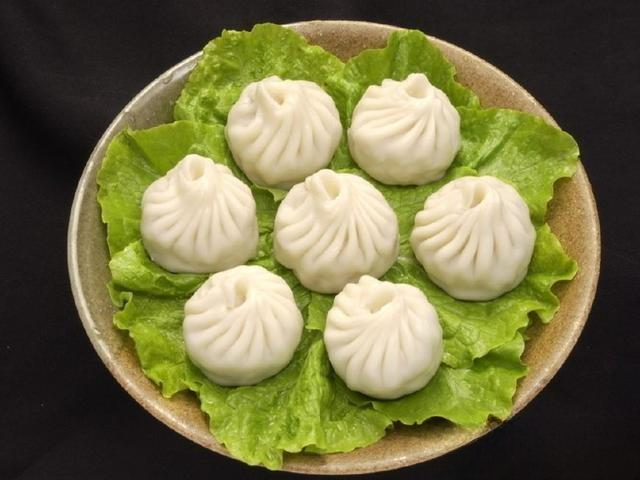
2. Sauce Roujiamo, a specialty food of Baoji, is very delicious. The taste and texture are different from the ordinary cured meat dumplings.
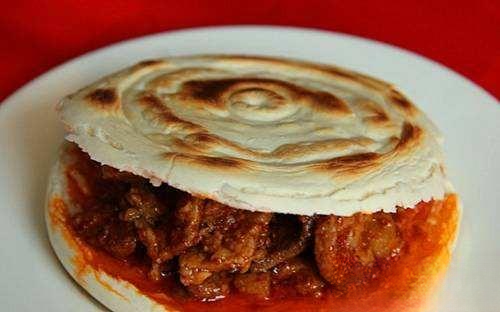
3. Qishan Wenwang Guokui. Qishan Wenwang Guokui has a long history. According to legend, King Wen of Zhou ate this Guokui when he set out from Zhouyuan, Qishan to punish King Zhou. It is made with meticulous craftsmanship and is known in Xifu for its dry, crispy, white, and fragrant texture.

4. Xifu vinegar noodles are one of the famous special snacks in Baoji City, Shaanxi Province. They taste sour and spicy, spicy and salty, leaving a long-lasting aftertaste.
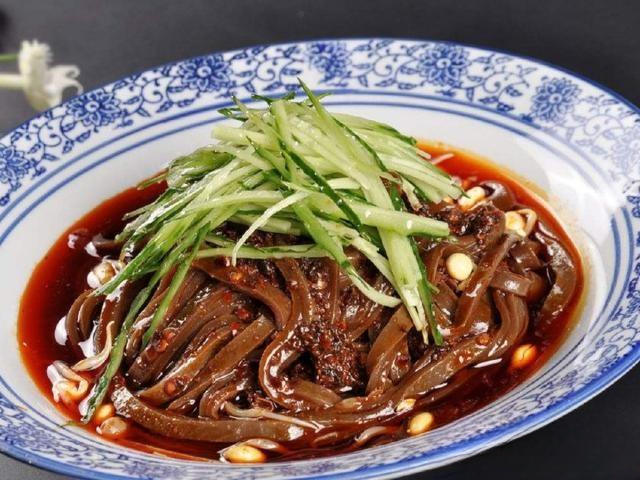
5. Fufeng baked noodles, which is second only to rolled noodles in the noodle family, is also delicious and chewy.
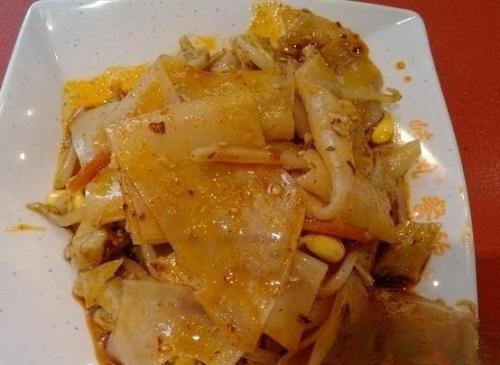
6. Baoji's rolled noodles. The most authentic method of making this kind of food must be from Qishan County. The earliest period of this technology should be the cold noodle making method in the Tang Dynasty. It can be regarded as an ancient technology!
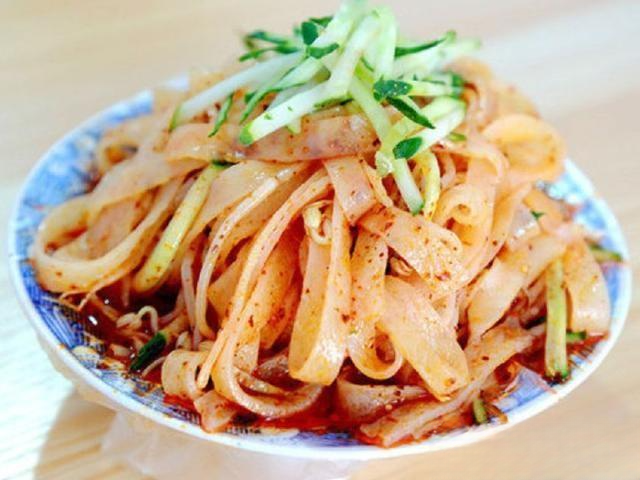
7. Qishan臊子面. I believe everyone has heard of this famous name. Many people have tasted it. It is sour, fragrant and delicious. It is especially tasty.
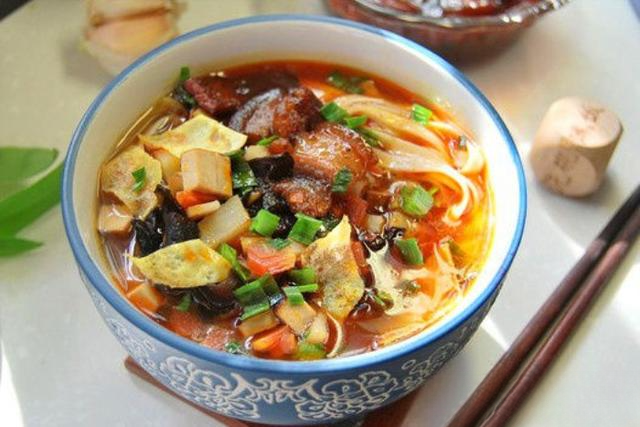
8. Baoji’s Xifu Pulled Noodles, a famous Chinese delicacy.

9. Qishan hollow noodles are a traditional noodle snack with a long history in Qishan County, Shaanxi Province. They are the most unique and high-quality traditional handmade noodle food in the lives of local people.
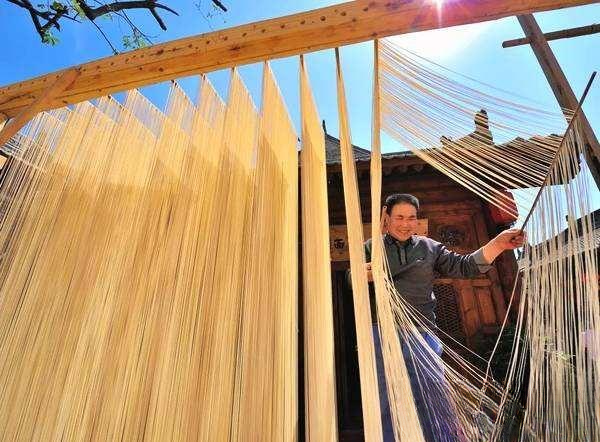
10. Baoji Jiaotuan, the authentic Jiaotuan is transparent and crystal clear, shaped like white jade, paired with bright red oil and vinegar water, and green leeks. It is really delicious in color, aroma and taste. In the hot summer, eating a bowl of cold Jiaotuan will make you refreshed immediately and leave you with an endless aftertaste.
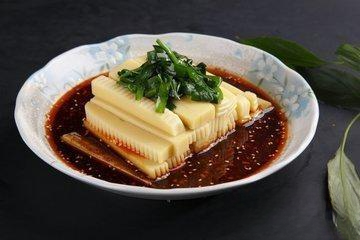
11. Persimmon noodle soup, a Baoji specialty, is made with persimmons, a specialty of the Guanzhong region, and flour. Its main characteristics are a crispy outer skin and a soft, sweet inner flesh.
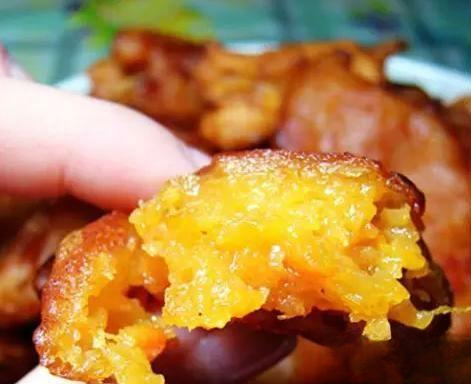
12. Konjac tofu is a new type of health food, which belongs to Sichuan cuisine. As long as the raw material is konjac, konjac is very beneficial to the human body. It not only has the effect of detoxification and beauty, but also has a therapeutic effect on obesity. So even if you eat too much, you don’t have to worry about gaining weight.
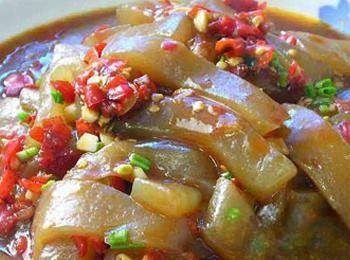
13. Tofu pudding steamed bun, a snack from Fengxiang County, is very famous in Xifu, but it can only be found everywhere in Fengxiang and is rarely sold in Baoji.
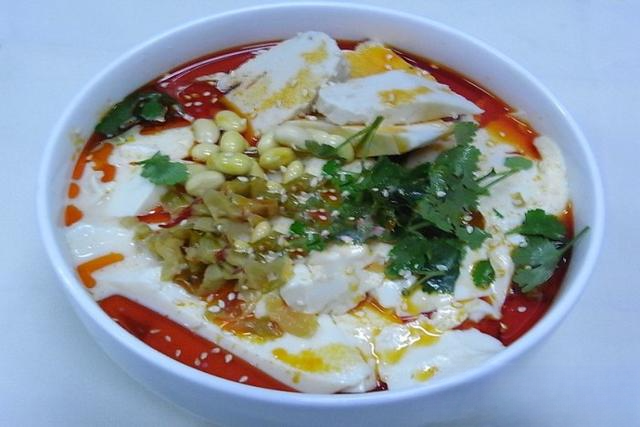
14. Baoji Golden Thread You Tart, Golden Thread You Tart originated in the Tang Dynasty. Its main raw materials are high-quality flour and pork fat. Its appearance is thin and fine, golden and translucent, and the taste is soft and not greasy, and it is refreshing.
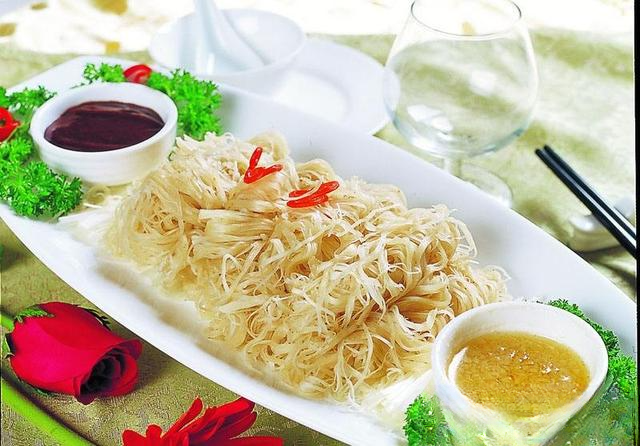
15. Fufeng Deer Cake is a famous traditional snack in Fufeng County, Baoji City, Shaanxi Province. It tastes sweet, crispy and delicious.
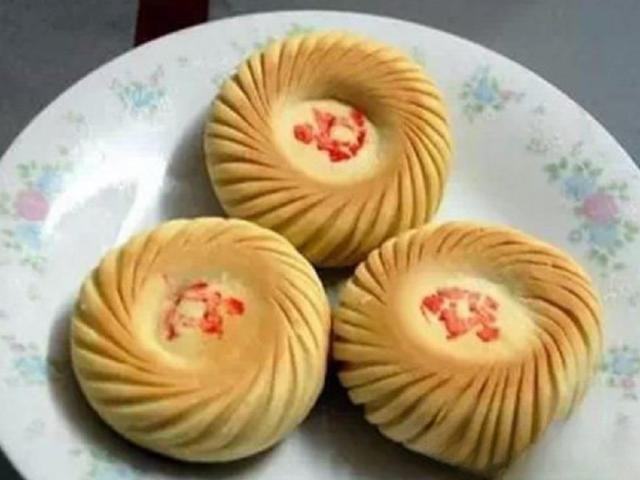
16. Longxian Horse-Tips Pastry, Longxian Horse-Tips Pastry, also known as Honey Filling Pastry, is named after its round shape resembling a horseshoe. It is a precious pastry that people in Longxian eat when visiting relatives and friends.
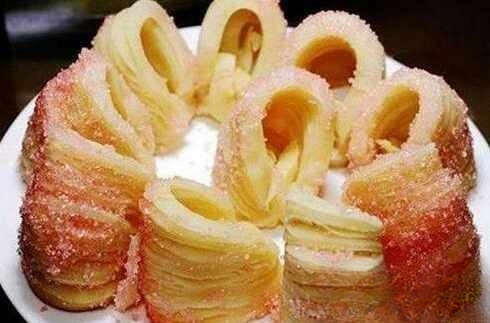
17. Baoji Tea Cake is said to have originated from a local man named Tuwa during the Xianfeng period of the Qing Dynasty. He started to make a snack named Tea Cake and gradually became famous. His tea cake was famous for its color, fragrance, taste and shape, and was known as "Tuwa Tea Cake".
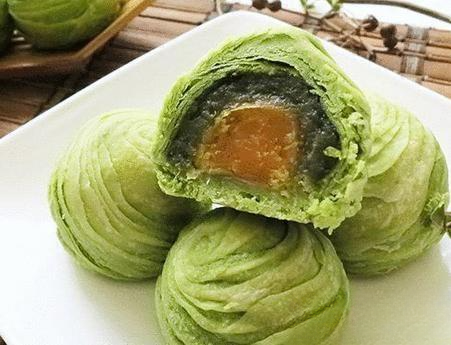
18. Cured donkey meat. As the saying goes, there is dragon meat in the sky and donkey meat on the ground. The best donkey meat is produced in Fengxiang, Baoji. Even Mr. Lafayette praised this delicacy. How can it be bad?
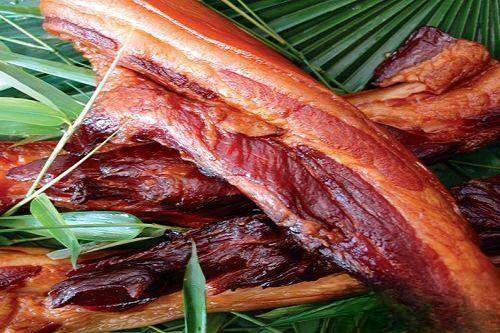
Baoji Snacks* Baoji Snacks
Baoji on the Tip of the Tongue
Shaanxi Baoji Specialty - Fengxiang Cured Donkey Leg Baoji's Eighteen Delicacies
1. Hehe
Hele (pronounced hele), also known as helou or hele, is made by mixing pea flour, oat flour, buckwheat flour or other mixed bean flours until soft. The flour is pressed through the holes on a hele bed (a wooden or iron tool with many round holes) to form small round strips. It is thicker than ordinary noodles, but firmer and softer than noodles. It is eaten in a similar way to noodles. Bean flour sometimes needs to be added with dough to adjust the hardness and taste of the noodles. It is suitable for noodles that are not as sticky as wheat flour and cannot be made into noodles by ordinary methods. Wuji hele is the most famous and common in the north, especially in Shanxi[1] and Shijiazhuang. It is also common in the southeast of Zhao County, Shijiazhuang and the border of Ningjin County, Xingtai.

2. Qishan Saozi Noodles
Saozi noodles are a Han Chinese noodle dish and a famous Xifu snack from Northwest China. The most authentic version is from Qishan, Baoji. Popular in areas like the Guanzhong Plain in Shaanxi and eastern Gansu, Saozi noodles have a long history. They are often served with side dishes like tofu and eggs, and are simple to prepare. In the third chapter of "Water Margin," it's mentioned: "In compliance with the order of the Minister of State, I request ten pounds of lean meat to be cut into Saozi." The Saozi here refers to diced meat.
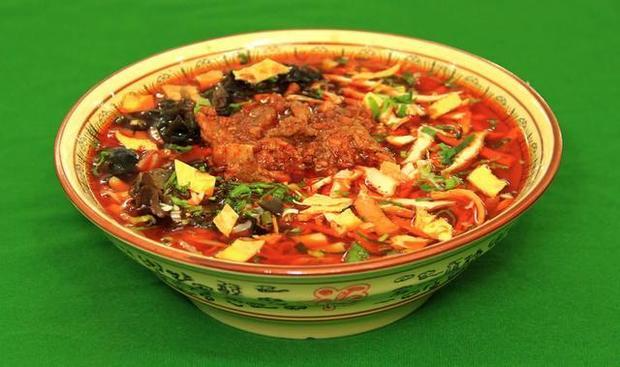
3. Baoji Tea Cake
The legend goes that it originated from a local man named Tuwa during the Xianfeng period of the Qing Dynasty. He started to make a snack named Tea Cake and gradually it became famous. His Tea Cake was famous for its color, fragrance, taste and shape, and was known as "Tuwa Tea Cake".

4. Dry foot stick
Dry feet (jue) and bang (bang) are Han Chinese dishes from Feng County, Shaanxi Province. Known elsewhere as red-braised pig's feet, Feng County uses bacon and pork legs, with specific restrictions on the type and time of slaughter and the cooking method. In the past, it was a common dish served by mothers-in-law to their sons-in-law.
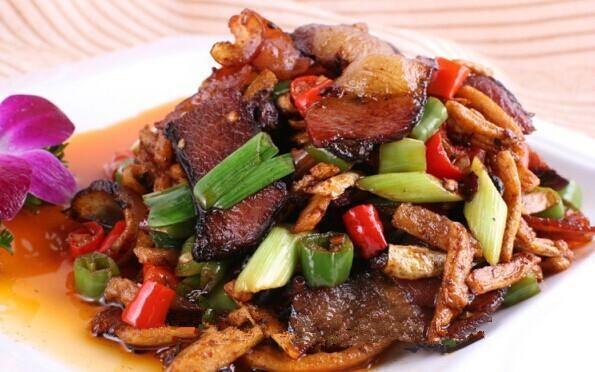
5. Fufeng Deer Cake
Deer cake steamed buns are a traditional Han Chinese snack from the Guanzhong region of Shaanxi Province. They are sweet and crispy, and the more you chew, the more flavorful they become, leaving a lingering aftertaste. "Qishan's noodles, Fengxiang's wine, and Fufeng's deer lamb steamed buns, both good for Beijing," are two famous sayings circulating in the Guanzhong region's Western Prefectures. These phrases describe the culinary culture of these prefectures, which has nurtured numerous renowned snack brands. Fufeng's deer lamb steamed buns are one such example. Their popularity, particularly thanks to Empress Wu Zetian, catapulted them to fame, a tradition that continues to this day.
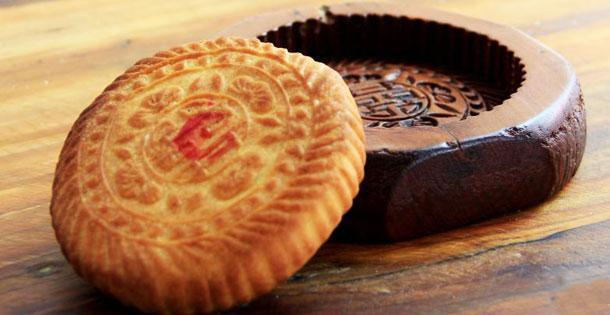
6. Deer Cake
Deer cake is a baked steamed bun, a famous Han Chinese snack in Fufeng County, Shaanxi Province. Its production is limited to a few villages around Sibao Village, east of the county seat; no other places in the county can make it. It's made by baking high-quality flour with sugar, oil, five-spice powder, and other ingredients. The bun is decorated with a deer pattern. It has a bright white color and a sweet flavor. It doesn't fall apart when cooked or mold when stored. In the past, it was often carried and eaten by travelers. The history of deer cake dates back to the Tang Dynasty. Legend has it that when Empress Wu Zetian visited Famen Temple to worship Buddha, she passed by Fufeng County and saw a vendor selling deer cake buns. At the time, they weren't called deer cake buns, but "Zhu Ding Shi buns," because they resembled a drum-shaped Zhu Ding stone with a hollow in the middle. Empress Wu Zetian ate the bun and found it delicious. She noticed a seal carver next to the vendor, so she picked up a deer cake image and stamped it into the hollow of the bun, naming it "Deer Cake Bun." Since then, the deer cake bun has been passed down from generation to generation.
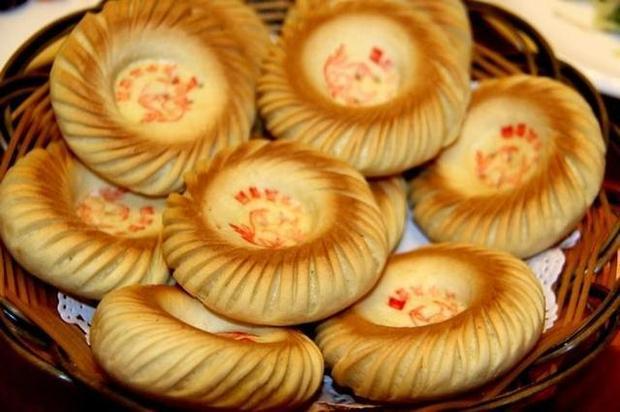
7. Fufeng Yikouxiang
Fufeng Yikouxiang is a traditional specialty snack from Fufeng, Shaanxi. Based on the Qishan Zaozi noodles, it's meticulously crafted. Just one bite will leave you wanting more. First, make the shaozi noodles. Pan-fry the eggs into thin pancakes and cut them into diamond shapes. Chop the chives and dice the pork belly. Add the scallions, ginger, garlic, and chili peppers and stir-fry over high heat for about 20 minutes. Prepare the noodles: Boil the noodles until they're about half done, remove them, and rinse them in cold water. Add the broth to the water to create a stock, boil for about 10 minutes, season, and add the shaozi noodles. Place an appropriate amount of noodles in a bowl and pour the broth over them, making sure the broth covers the noodles. A generous amount of broth ensures the noodles are fully absorbed.
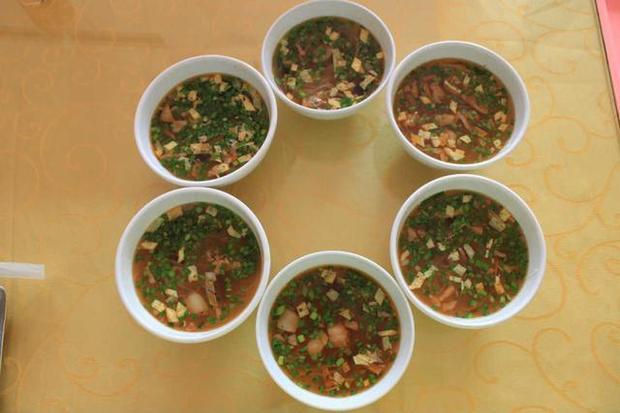
8. Xifu Vinegar Powder
Vinegar rice noodle is a Han Chinese snack from Xifu, Shaanxi. Made with water from the Meiyang River, it's soft, clear, and has a sour, spicy, and salty flavor, creating a tangy, refreshing aroma that leaves a lasting aftertaste. After the vinegar is brewed, the lees are filtered, leaving only the starchy residue. This is then mixed with wheat flour and mixed into a thin batter. This batter is then poured into an iron basket and steamed. Once cooled, it's cut into thin strips and mixed with vinegar, salt, garlic juice, and chili oil. This creates the distinctive Xifu vinegar rice noodle, with its slightly sour taste and rich aroma that whets your appetite.
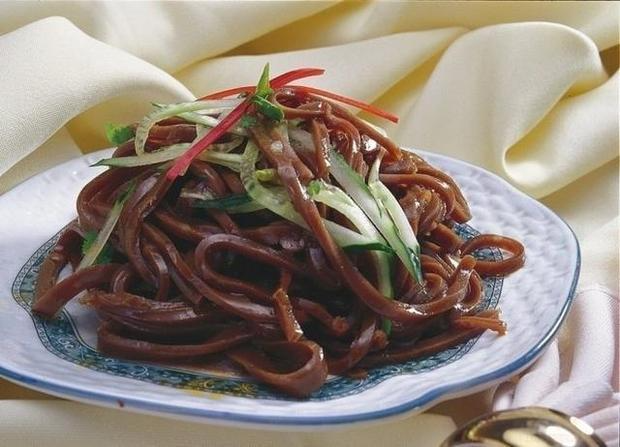
9. Tofu Pudding Soup with Steamed Bun
Tofu pudding steamed bun is a traditional Han Chinese snack native to the Xifu region of Shaanxi Province (present-day Fengxiang County, Baoji City, Shaanxi Province). The bun, over an inch thick and shaped like a wok, is baked using a unique technique and seasonings. It's commonly known as a "guokui" (a type of steamed bun), and is cooked to perfection with precise cooking conditions and a rich, wheaty aroma. The bun, shaved thinly with a sharp knife, resembles golden leaves. The tofu pudding, made using traditional methods from high-quality soybeans, is tender and smooth, remaining firm even after cooking. Tofu pudding steamed bun is extremely popular in Baoji. In recent years, the dish has rapidly expanded to become a popular dish in many streets and alleys throughout Shaanxi and beyond.
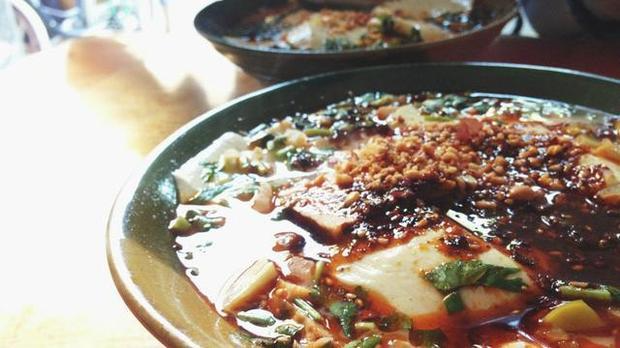
10. Baked dough
Fried noodle skin, a traditional specialty snack in Shaanxi Province (most famous in Pingtou Town, Baoji City, Shaanxi Province), has the flavor characteristics of being "tough, chewy, dry, and low in water".
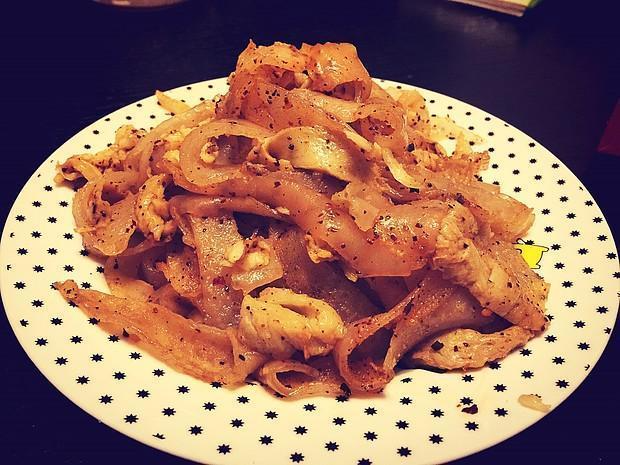
11. Sesame sauce cold noodles
Sesame sauce cold noodles is the name of a dish that tastes spicy and delicious, has bright colors and is relatively simple to make.
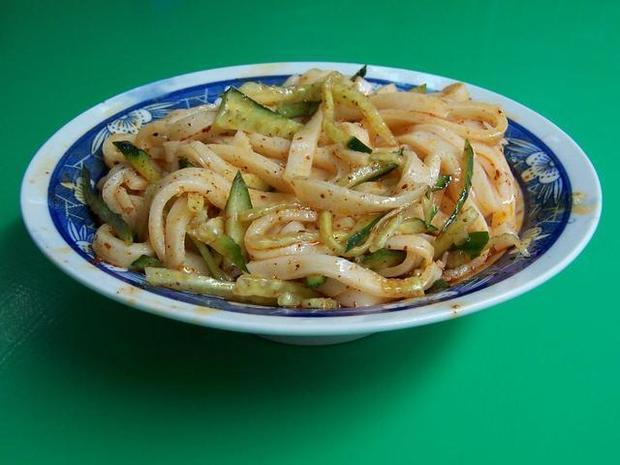
12. Xifu Pulled Noodles
Pulled noodles are a traditional noodle dish from Shaanxi and Shanxi provinces. They are primarily popular in Shaanxi, Shanxi, and the counties of Huixian, Liangdang, and Chengxian in Gansu. They boast a 3,000-year history. The most authentic version is Xifu Pulled Noodles from Baoji, a renowned Chinese delicacy.
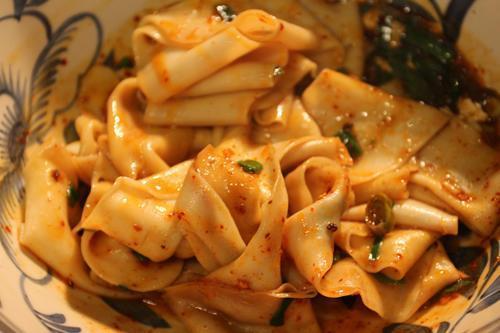
13. King Wen’s Guokui
According to legend, Qishan Guokui originated during the time of King Wen of Zhou, and is also known as "King Wen Guokui." Guokui gets its name from its shape resembling the bottom of a pot and being as large as a pot lid.
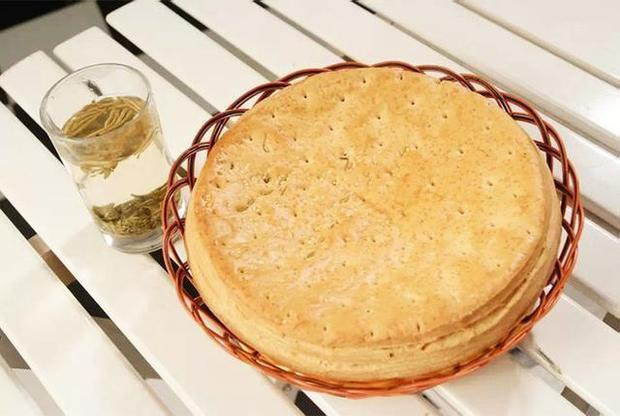
14. Money Meat
Longxi Jinqian Meat, also known as Longxi Butterfly Meat and Jinqian Melo Meat, is a traditional specialty of Gansu Province. It has been listed as a tribute by successive courts since Emperor Yang of Sui tasted it during his western tour. It has a long history. The product is made of carefully selected ingredients and finely crafted. It has a rosy color, is crystal clear, and is rich in gelatinous elasticity, tender, mellow, and has a long aftertaste. Therefore, it is known as "the best of Longyuan".
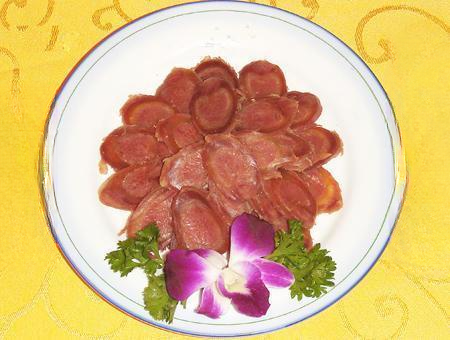
15. Cured donkey meat
Cured donkey meat is made from carefully selected fresh donkey meat with alternating fat and lean parts, seasoned with traditional Chinese medicines such as dried tangerine peel, cinnamon, and angelica root, and prepared using a special process. Donkey meat is high in protein and low in fat, making it particularly suitable for the elderly, children, the infirm, and those recovering from illness.
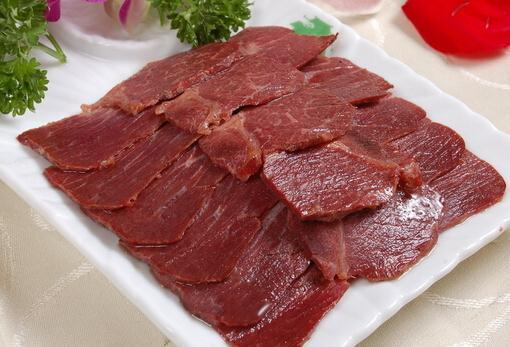
16. Donkey Meat Soup with Steamed Bun
Donkey meat steamed buns (soup with steamed buns) are a famous Han Chinese snack. Donkey meat steamed buns are inseparable from the donkey meat soup, and the preparation of this soup is very important. The success of a donkey meat steamed bun restaurant depends on this good soup. Each steamed bun restaurant has its own secret recipe, which mainly varies in the spices used. We have collected some traditional family recipes, and the flavor is also very good.

17. Braised pork bun with preserved juice
Lazhi Roujiamo (bacon-fried pork burger) is a local specialty snack in Shaanxi Province. The name "roujiamo" originates from ancient Chinese. The traditional Shaanxi lazhi Roujiamo recipe involves preparing the marinated bacon (selecting ingredients and cutting techniques, salting and drying, and braising the meat) and the Baiji steamed bun. It's primarily made with pork belly, flour, broth, and various spices and seasonings.

18. Pan-fried dumplings
Baoji famous
snacks
Qishan Saozi Noodles
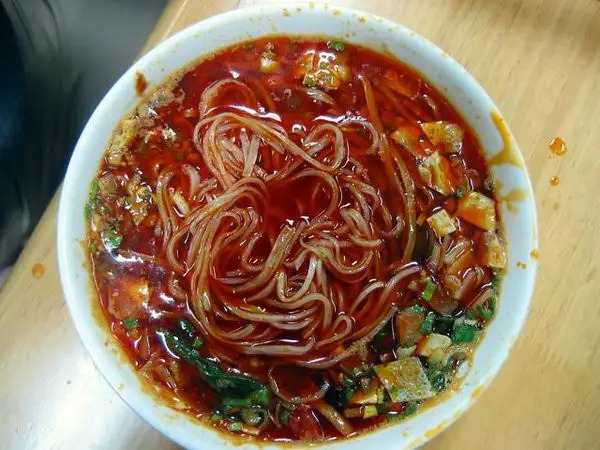
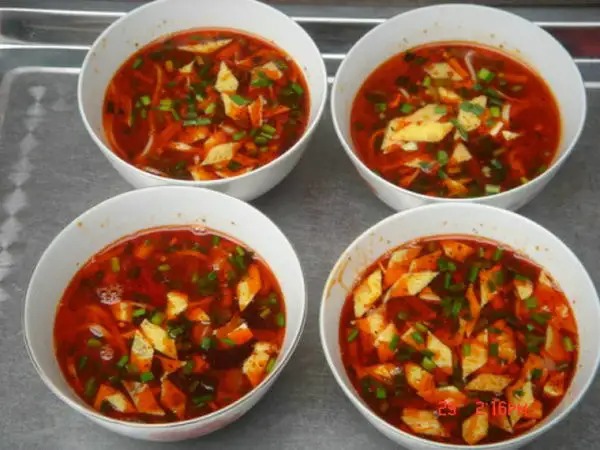
: Legend has it that during the reign of King Wen of Zhou, a large dragon often haunted the Wei River below the Qishan Plain, harming the people. Upon learning of this, King Wen ordered the destruction of the scourge. Legend has it that dragon meat is delicious and can ward off evil and prolong life. King Wen then ordered the dragon chopped into small pieces and distributed to the people. Eating the dragon meat boosted the tribe's prosperity, strengthening the people, and ultimately strengthening the tribe. From then on, the people continued this tradition of chopping meat into small pieces, stir-frying, and eating it to pray for peace and prosperity throughout the year.
Through long-term culinary practice, later generations dubbed this diced meat dish "saozi." It boasts a unique and delicious flavor, neither fishy nor greasy, and can be enjoyed on its own or mixed with other foods. It also preserves well, gradually becoming a local delicacy. The people of Qishan combined sauerkraut (臊子) made with large amounts of meat with local noodles, creating the unique Qishan sauerkraut noodles, which quickly became renowned and renowned for its delicious flavor. The sauerkraut noodles, originally served at the "Qishan Zhaobi Houbei Noodle House," were praised by the imperial court for their efficient management, unique craftsmanship, and excellent taste.
Qishan sauerkraut noodles, or noodles topped with large amounts of meat in a broth, are highly sought after in Shaanxi Province due to their economic viability. In rural Guanzhong, they are a staple dish served during festivals, weddings, and funerals. Three key characteristics distinguish this dish: the broth is sour, spicy, and fragrant; the noodles are thin and succulent; and the overall texture is pan-fried, thin, and hearty.
The sauerkraut production process dates back to the Zhou Dynasty. Qishan sauerkraut noodles are prepared with a broth containing large amounts of meat, cauliflower, wood ear mushrooms, tofu, kelp, and a variety of savory and fragrant vegetables.
Saozi, or diced meat, is characterized by its "fragrant but not greasy flavor and excellent color and flavor." As the saying goes, "A sharp sword is forged through constant grinding, and the fragrance of plum blossoms comes from the bitter cold." To achieve this state of mind, the diced meat undergoes a grueling process: first, it is placed in a giant iron pot with bones and cooked over a blazing fire. Once the meat is cooked, it is removed, the bones removed, and the meat is chopped and wrapped in gauze. Finally, it undergoes this "torture" again. After all these hardships, the exceptional diced meat is finally "born .
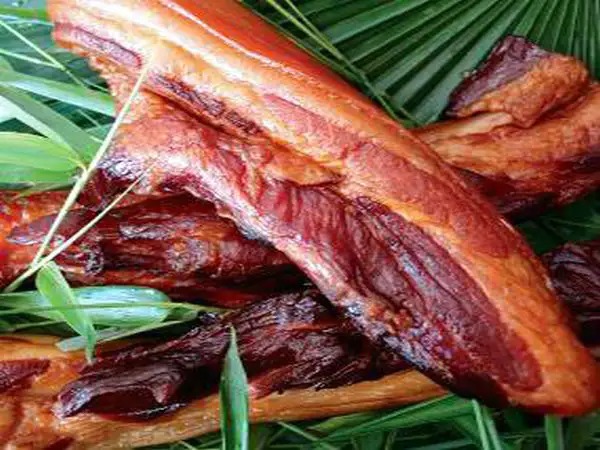
donkey meat are known to replenish qi and blood, and benefit the internal organs. They are an excellent tonic for those suffering from years of strain, those recovering from long-term illness, qi and blood deficiency, shortness of breath, fatigue, and loss of appetite. This is why there's a saying: "Dragon meat in heaven, donkey meat on earth." The Guanzhong region of Shaanxi is home to the nationally renowned "Guanzhong donkey."
Cured donkey meat was invented during the Xianfeng period of the Qing Dynasty. Cured donkey meat is made from premium donkey meat, which is sun-dried, pressed, boiled, and marinated throughout the summer, autumn, and winter. The resulting slices are bright red, the texture is delicate, crispy, and tender, and the flavor is delicious and lingering. The "qianqian meat" (qianqian meat) is particularly renowned as the finest cured donkey meat.
Fengxiang cured donkey legs are made from the finest donkey legs. They are rosy in color, fine in texture, crispy, fragrant, and delicious, with a perfect balance of flavors that makes them a never-ending delight.
Fengxiang cured donkey legs are a long-standing traditional meat specialty of Fengxiang County. Legend has it that during the late Qing Dynasty, a man named Su Shiwa made cured donkey legs renowned for their distinctive characteristics. He passed down the production and processing techniques for these legs to future generations.
Su Shiwa, who spent his life curing scraps of cattle and donkeys, prepared cured donkey legs every winter. Because Su's unique technique resulted in limited production, the legs were extremely rare and expensive, making them rarely available to the general public. Instead, they were often presented to superiors by officials, wealthy individuals, merchants, and the wealthy as precious gifts during the Spring Festival and Lantern Festival, and given to relatives and friends.
Su Shiwa's meticulous craftsmanship resulted in a rosy red color and a delicious flavor. The "qianqianrou" (the male donkey's external genitalia) is particularly distinctive, making it not only a refreshing and delicious accompaniment to alcohol, but also renowned for its aphrodisiac and kidney-tonifying properties, making it renowned in Guanzhong.
Several companies in Fengxiang County now produce these cured donkey legs, making them a popular gift for guests and family banquets .
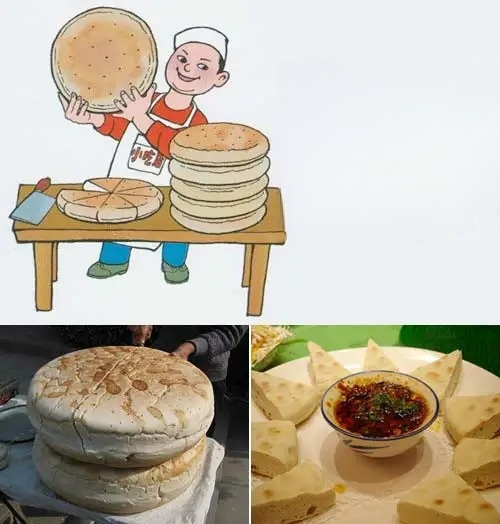
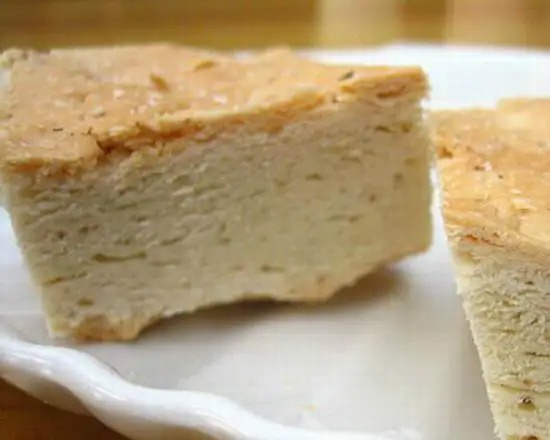
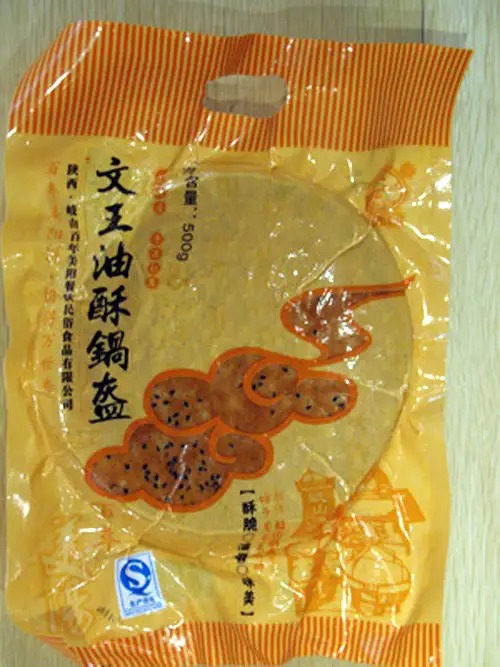
(Wenwang Guokui) Qishan Guokui (baked steamed bun) boasts a long history and meticulous craftsmanship, renowned for its dryness, crispness, whiteness, and fragrance
. According to legend in Xifu, Qishan Guokui originated during the time of King Wen of Zhou, earning it the nickname "King Wen Guokui." Guokui gets its name from its shape, which resembles the bottom of a pot, but is as large as its lid. Its fine dough is crispy, oily, and delicious. During its preparation, the dough is kneaded with salt, oil, and spices, then repeatedly pressed with a wooden frame, coated with sesame seeds, and baked over low heat, resulting in a crispy, yellowish color and a delicious flavor.
Since the Tang and Song dynasties, Qishan City boasted numerous post stations, allowing merchants to travel east and west, north and south. Qishan Guokui served as their go-to rations, carrying them far and wide. Since the Ming and Qing dynasties, Guokui makers and sellers have spread throughout the county. Zhang Cong and Liu Youxue of the Guangxu era; Xing Daizi, Zhao Qianer, and Zhang Guangshan of the Republic of China; and Pang Tianhong and Xi Jinluan since the founding of the People's Republic of China, all served as experts in this field .
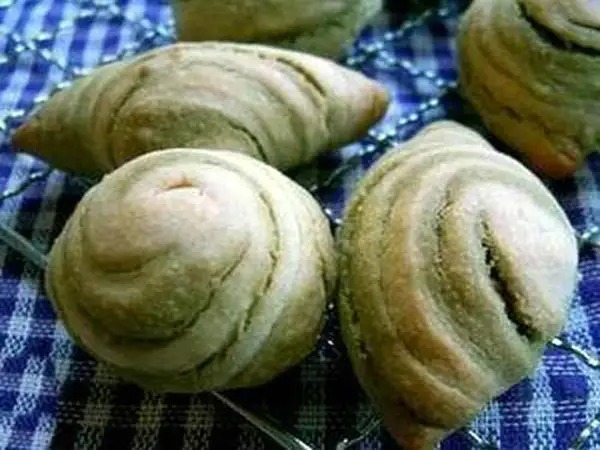
Pastry: The name "Cha Su" (cha su) comes from the "cha su" (cha su) meaning crispy on the outside and crispy on the inside (cha is a Baoji dialect term describing the crisp sound when consuming tea pastry). It is best enjoyed with fragrant tea, enjoying the tea and crispy texture, creating a unique flavor. Therefore, "Cha Su" is also known as "Cha Su." With subsequent refinements in the production process, scrambled eggs with leeks or fried eggs with toon are now added to the freshly cooked tea pastry, further enhancing its aroma and flavor. Legend has it that during the Xianfeng period of the Qing Dynasty, a local named Tu Wa first created a snack, naming it "Cha Su." His tea pastry, known for its color, aroma, flavor, and shape, earned him the nickname "Tu Wa Cha Su." Tu Wa's craftsmanship was later inherited by his apprentice, Gen Cheng. In 1927, brothers Lu Jin Cheng and Lu Zi Qing, local residents, became apprentices to Gen Cheng, learning how to make this snack. Imbued with his skills, their delicious tea pastries earned a high reputation in Baoji. In 1956, Lu Ziqing joined a collective enterprise and took Zhang Qiulan as his apprentice at the Sanhao Canteen in Baoji City, where he passed down the art of making tea pastries. Since then, tea pastries have become a local delicacy, beloved and celebrated.
Research suggests that the name "cha pastry" (cha pastry) is derived from the "cha pastry" (cha pastry), which means "cha pastry" (cha pastry) and "crisp pastry" (cha pastry) in Baoji dialect, describing the crisp sound of the pastry when eaten. It is often enjoyed with fragrant tea, creating a unique flavor. Therefore, "cha pastry" is also known as "tea pastry." Subsequent refinements have led to the addition of scrambled eggs with leeks or toon eggs to freshly cooked tea pastries, further enriching their flavor and savory taste.
Made with white flour, lard, rapeseed oil, and seasonings, the dough is primarily oil-based and pan-fried in a flat pan. The key is controlling the heat. The resulting tea pastry boasts a golden color, a crispy exterior, a soft interior, and a non-greasy texture. It is crispy and delicious, with layers of delicate, succulent texture and a distinct crunch .
Fengxiang Tofu Pudding Steamed Bun 
Fengxiang Tofu Pudding Steamed Bun
If you're looking for an economical and convenient breakfast, Fengxiang Tofu Pudding Pao Mo is your first choice in Baoji. To prepare it, place small pieces of Guokui (a steamed bread) into a pot of soy milk and simmer for a short while. Pour the mixture into a bowl, then scoop the hot tofu pudding onto the top, top it with soy milk, and serve with seasonings. Quality requirements require the tofu pudding to be tender, the soy milk to be properly fried, and the chili oil to be thick. It has a salty, spicy, and fragrant flavor, is highly nutritious, and is easy to digest. It has become an affordable breakfast in Baoji, Fengxiang, and other areas.
This tofu pudding steamed bun recipe is simple, but getting it right is not. First, choose the best Fengxiang guokui (Chinese steamed bun). Anything else won't do. Fengxiang guokui must be the only choice. The chef slices the guokui and places it in a bowl. The amount of steamed bun depends on your appetite. The chef hands the bowl to the chef, who pours the guokui into a pot of boiling soy milk and cooks it for a while (it's actually a little different from the soy milk we usually drink). Then, he removes the guokui from the bowl, scoops two or three spoonfuls of hot tofu pudding onto the steamed bun, and pours the hot soy milk over it. First, scoop a spoonful, then sprinkle with salt, then a few more spoonfuls. Finally, pour in chili oil—a much stronger chili oil than the usual oil-splashed chili oil. The bowl is finished, with a hint of red in the white, and then a hint of white in the red. This tofu pudding is unique, a bit tougher than the usual tofu pudding, but a bit more tender than soft tofu, with just the right firmness.
Many outsiders think that tofu pudding steamed bun is unappetizing, with a simple recipe and a monotonous flavor. This is simply because they don't understand it and haven't truly experienced it. If it weren't tasty, Fengxiang people wouldn't eat it every day for breakfast. However, tofu pudding steamed bun contains tofu pudding, which also contains a lot of protein. Eating it regularly is good for your health, as verified by others. It's also said to be a good breakfast choice for those with a weak stomach.
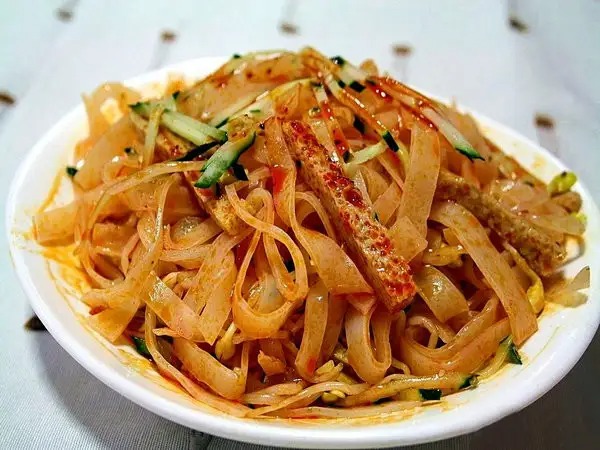
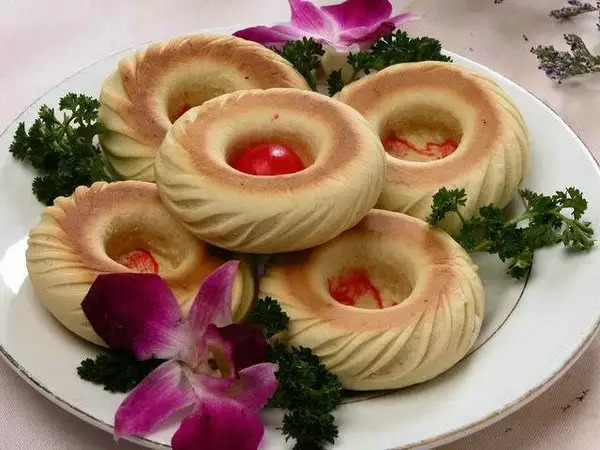
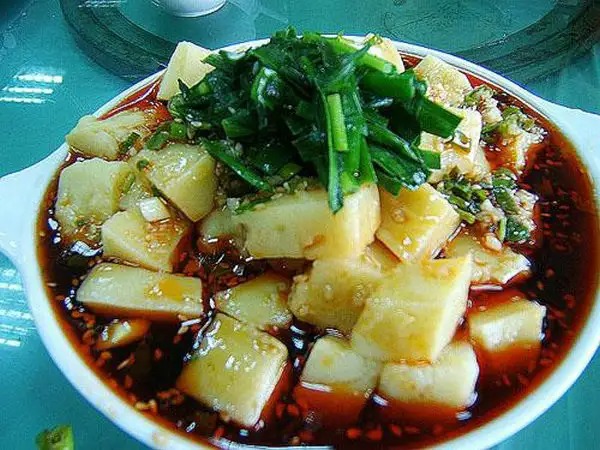
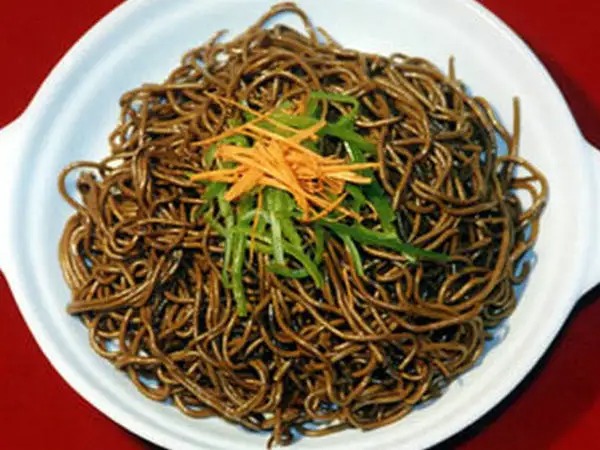
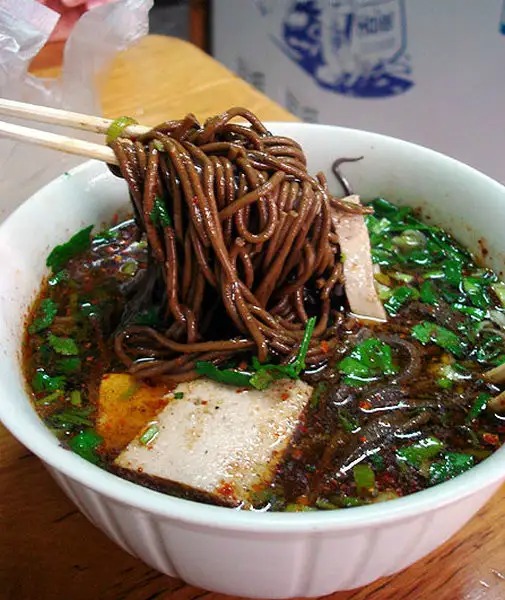
Buckwheat noodles have a history of 600-700 years. "Buckwheat noodles are black, chewy, and delicious enough to entertain guests" is how people praise them. They are made from freshly ground buckwheat. They can be eaten hot in winter or cold in summer, strengthening the stomach and relieving summer heat.
There are two ways to eat buckwheat noodles, one is to eat them hot and the other is to eat them cold.
Qishan Noodles

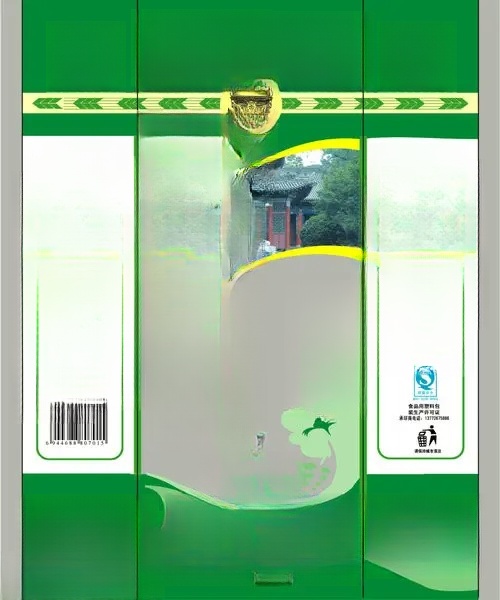
Qishan Noodles
Qishan dried noodles have long been considered a Shaanxi specialty. In Qishan County and some areas of Xifu, they were often given as gifts to close relatives and friends, typically during the Lunar New Year. Dried noodles were a must-have when giving a "four-color gift," a ritual of four items, a solemn gesture. However, in Qishan County, dried noodles were not given as gifts to families specializing in making dried noodles, as they were considered "exceptionally skilled in front of an expert."
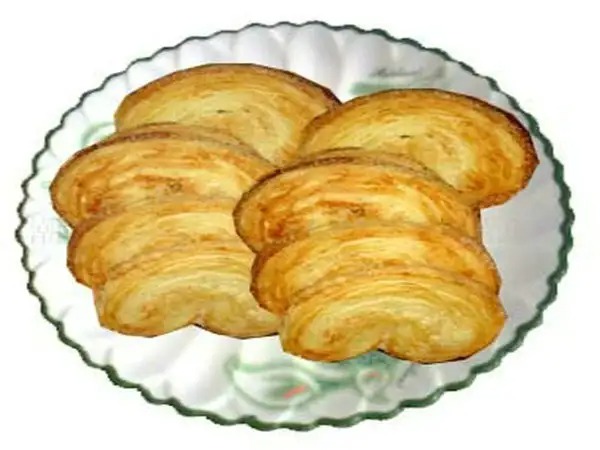
Pastry, also known as Honey Filling, gets its name from its round shape resembling a horseshoe. The recipe and method were learned by a skilled local chef from the imperial chef, and later spread to the local public.
The main ingredients and methods include refined flour, cooked lard, white honey, and white sugar. Refined flour is mixed with water and a small amount of lard to form a dough, which is then rolled into a crispy dough. This dough is then rolled into a roll with the lard, shaped into a horseshoe, and deep-fried in a large pan.
The layers of the lard are as thin as paper, with excellent color, aroma, flavor, and shape. They are renowned for their refined ingredients, meticulous craftsmanship, and soft, non-greasy texture, sweet flavor, crispy texture, rich nutrition, and longevity.
They are produced at the Longxian Food Processing Factory .
Persimmon paste mat
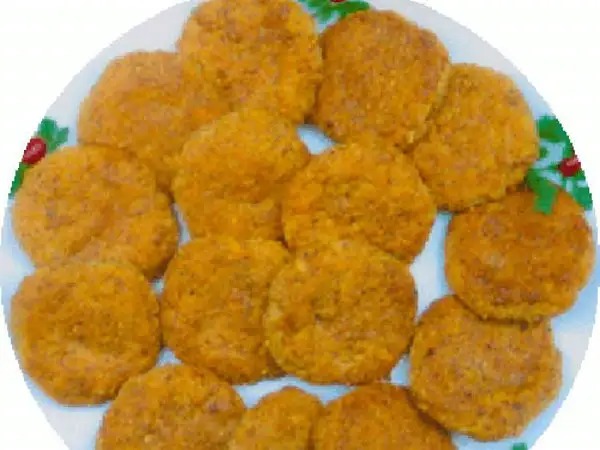
Persimmon flour huta is a simplified version of Huanggui persimmon cake, still primarily made from persimmons. The persimmon flesh, after removing the skin and stalks, is blended into a paste. Flour is then added and mixed until the paste is the desired consistency. Using a spatula, the paste is spread into a round, portable iron tray (called a huta tray in Xi'an) and deep-fried in hot oil. When the huta is cooked to a certain degree, it will lift off the tray and float, allowing the operator to remove the tray and continue cooking.
Nutritional value
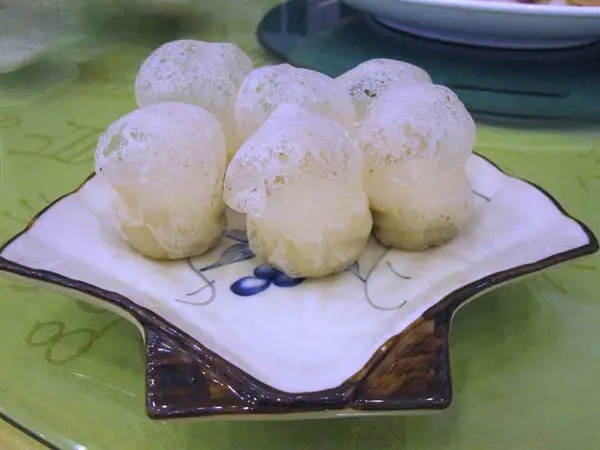
.
Hemangma food
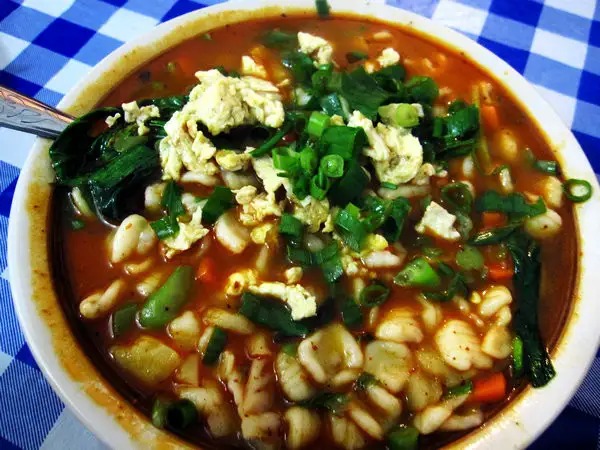
Ma Shi is in the shape of a date pit and is hollow in the middle. After it is made, the main and auxiliary ingredients are blended together, making it chewy, smooth and full of local flavor.
Buckwheat pancakes
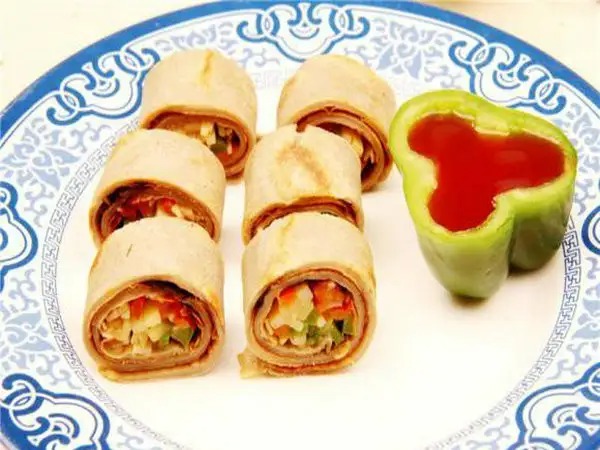
essential amino acid. Buckwheat is rich in dietary fiber, with a content 10 times that of refined rice.
Buckwheat also contains more trace elements such as iron, manganese, and zinc than other grains. Buckwheat is also rich in vitamin E, soluble dietary fiber, niacin, and rutin (rutin). Rutin can lower blood lipids and cholesterol, soften blood vessels, protect eyesight, and prevent cerebral hemorrhage. Niacin promotes metabolism, enhances detoxification, and dilates small blood vessels, lowering blood cholesterol.
Buckwheat is rich in magnesium, which promotes fibrinolysis, dilates blood vessels, inhibits blood clot formation, and has anti-thrombotic properties. It also helps lower serum cholesterol.
Buckwheat contains certain flavonoids that have antibacterial, anti-inflammatory, antitussive, antiasthmatic, expectorant, and blood sugar-lowering properties.
Traditional Chinese Medicine believes that buckwheat, with its cool nature and sweet flavor, can strengthen the stomach, eliminate stagnation, and stop sweating. The "Compendium of Materia Medica for Dietary Therapy" states that it "tonifies the stomach and intestines, replenishes energy, and sustains spirits." The "Sui Xi Ju Dietary Guide" states that it "stimulates appetite, relaxes the intestines, replenishes energy, and protects against cold winds." The "Illustrated Guide to Medicinal Plants" states that buckwheat "can reduce cold sweats."
Use buckwheat noodles to make pancakes and serve.
Main ingredients: buckwheat flour, dried tofu, crispy pork, sesame broth, fried chili peppers, and other condiments.
Brief Description: This pancake is made from a fine buckwheat flour paste. It's filled with dried tofu and crispy pork, and served with sesame broth or fried chili peppers. It's delicious, fragrant, and a distinctly local flavor.
Tofu
buns
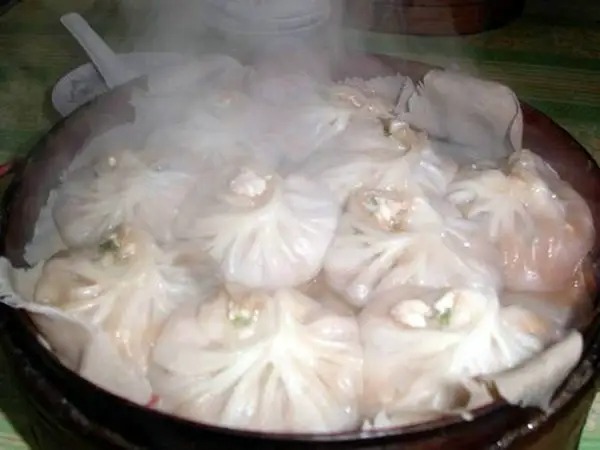
are a traditional specialty of Baoji City. Speaking of these buns, there's a legend about how the Duan family's tofu buns were awarded a dragon flag by the emperor: Legend has it that in 1703, during the 42nd year of the Kangxi Emperor's reign, Emperor Kangxi traveled westward to inspect Xinjiang and Gansu, passing through Baoji, Shaanxi. Dang Chongya, then retired and returning to his hometown, presented him with tofu buns from the Duan family noodle shop. These buns are made with flour wrappers, filled with diced tofu and various seasonings, then steamed. Their lantern-like shape is beautiful, and when eaten, a pinch of the bun opens the mouth, which is then filled with chili oil and other seasonings for a delicious, refreshing, and unique flavor. Emperor Kangxi, despite having tasted delicacies from land and sea, had never tasted such delicious buns. He was so pleased that he awarded them a triangular dragon flag. Since then, the Duan family's tofu buns have become incredibly famous, and have been passed down for over 200 years. They are not only beloved by locals but also praised by customers from other parts of the country. Under the tutelage of Qiang Kedu, the Duan family's heir, the tofu buns were once again recognized as a high-quality food. In May 1984, when Shaanxi Province's renowned chefs evaluated famous snacks and dishes, they also recognized Baoji tofu buns.
The main ingredients: refined flour, steamed tofu, and chives. Features: Shaped like a palace lantern, folded like flower petals, with a soft, gluten-rich skin and a tender, flavorful filling. For enhanced flavor, the buns are best served with a sauce (vinegar, chili oil, soy sauce, etc.) .
Golden Line Oil Tower
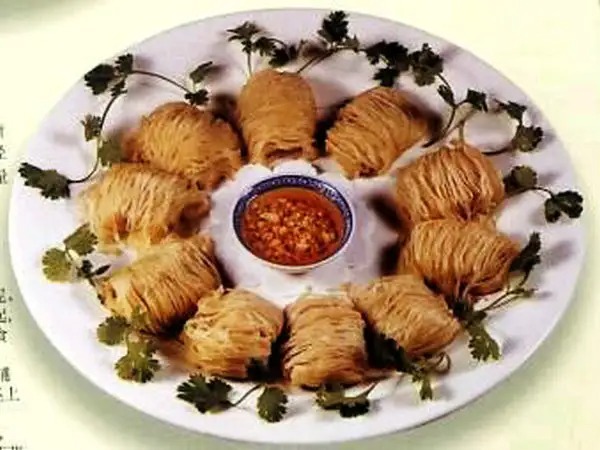
The golden thread oil pagoda has a long history, dating back over 1,400 years to the Tang Dynasty. Back then, it was called "you ta." Legend has it that an elderly maid in the household of Tang Prime Minister Duan Wenchang was a master crafter of this dish. According to the "Qingyi Lu," during the reign of Emperor Muzong of Tang, an elderly maid known as the "ancestor of food" mastered the art of making these oil pagodas. Over 40 years, she taught the technique to over 100 maids. Legend has it that only nine maids truly inherited the skills of Prime Minister Duan's maid, demonstrating the difficulty of mastering this art.
Cooking method: Steamed in a steamer
Flavor: Salty and fragrant with scallion sauce
2. Stretch and shape the dough into a disk. Roll the dough into a large square sheet about one-third thick. Evenly spread the peeled and chopped pork fat and salt mixed with seasoning flour over the dough. Then roll the dough up and cut it into long strips. Roll each strip into a one-and-a-half-centimeter-thick slice, then cut it into thin strips. Then, pull it apart by hand, stretch it into thin strips, and roll it into a round tower shape. This is the oil tower.
3. Steam the dough. Place a layer of thin dough on a steamer basket, arrange the oil towers in an orderly manner, and cover with another thin dough sheet. Steam over high heat for about 30 minutes until cooked.
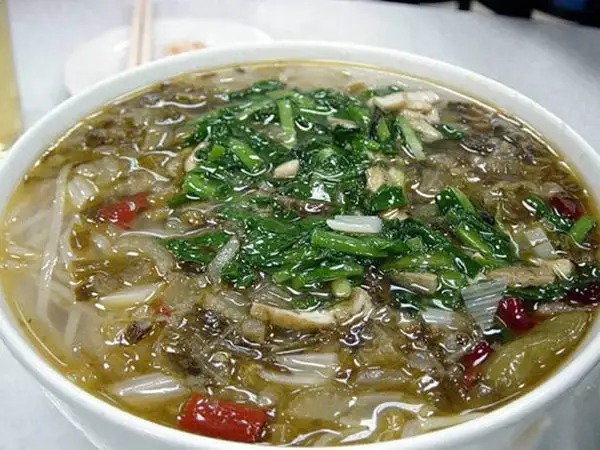
During the Chu-Han Contention, there lived a man named Han Er in Shaanxi. He had recently married, and he and his wife opened a small noodle shop, catering to sedan chair bearers and street vendors. At the time, vinegar hadn't yet become a thing. Han Er simply seasoned the sauce with oil and salt, making it taste unappetizing, and his business was slow.
"How is it? Is it delicious?" the middle-aged customer asked.
"Sour, spicy, and fragrant, it's really delicious!" The middle-aged customer nodded in approval.
The middle-aged customer had been running around for most of the day and was already hungry. He couldn't wait to ask the shopkeeper to pour a bowl over it. He took a sip and it was indeed delicious. So, the two diners ate and ordered more. The elderly diners finished four bowls in a row, and the middle-aged diners six. After finishing, the middle-aged diners wiped the grease from their lips and said to Han Er, "Shopkeeper, this sauerkraut noodles is really delicious. What do you think we should call it?" Han Er, delighted with this unexpected discovery, smiled and said, "The little one has dark eyes and no literary spirit. You should come up with a name." The middle-aged diners turned to their companions and said, "You have more literary spirit. You choose it!" The elderly diners stroked their gray beard and pondered for a moment before saying, "It's thick like water. I think we should call it jiangshui noodles!" "Okay!" The middle-aged diners and Han Er and his wife nodded in unison.
In this way, the reputation of jiangshui noodles, made by soaking cabbage in noodle soup for several days, spread. Han Er's small noodle shop was always crowded and business was booming. Later, he learned that the two guests that day were Liu Bang, the King of Han, and Xiao He, the Prime Minister. While incognito in Hanzhong, the emperor and his minister visited the people and unexpectedly discovered the recipe for making Jiangshui noodles. From then on, the recipe gradually spread .
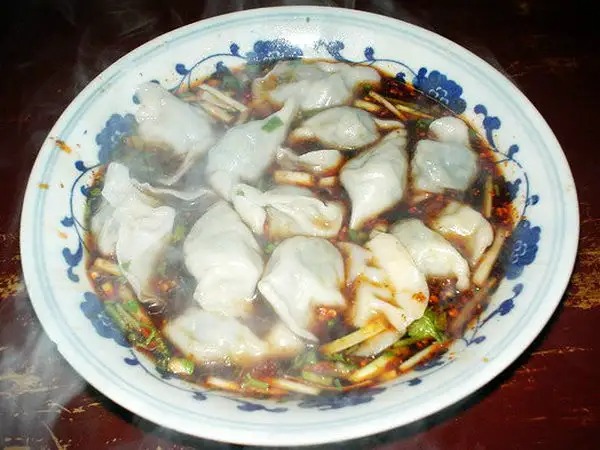
Sour soup dumplings are mutton dumplings served in a special sour broth. The broth contains 13 seasonings, including dried shrimp, cooked sesame seeds, chopped coriander, chopped chives, butter, sesame oil, chicken fat, sweet vinegar, and soy sauce. The sweet vinegar is made by adding 30% water, star anise, fennel, and cloves to vinegar, then steeping it. Brown sugar (a vinegar-to-sugar ratio of 50:1) is added and simmered for another half an hour.
First, knead the dough. It's important to prepare it two or three hours in advance for chewy dumplings. Use a ratio of 1/3 of flour to 1/200 grams of water, depending on the flour's condition; the dough shouldn't be too hard. Knead the dough at least three times until it's smooth and soft.
Ingredients (14 photos) Next, mix the filling. This example uses leek and pork dumplings, but the rest are similar. Combine the minced meat and leek filling in a 1:1 ratio, add one egg, chopped scallions, minced ginger, and sesame oil, and about 50 grams of broth (you can also use the same amount of water). Then add salt, MSG, pepper, and thirteen spices. Stir in the same direction (not in reverse) until the filling has absorbed all the water. Add the dumplings, cover the pot, and cook the filling. Uncover the pot and cook the skins. Finally, make the sour soup, which is a very delicate process. Shaanxi sour soup is essential with dried shrimp, cilantro, chopped scallions, and seaweed. For half a pound of dumplings, for example, add a little over 10 grams of salt, a dash of MSG, 15 grams of balsamic vinegar (it's absolutely crucial to use balsamic vinegar, otherwise the flavor will change), a dash of soy sauce, 20 grams of chili oil, a dash of chicken bouillon, dried shrimp, cilantro, chopped green onions, and seaweed to create a base. Rinse with the dumpling broth and scoop in the dumplings. A bowl of fragrant dumplings is ready.
The sour soup is uniquely prepared, delicious and sour, and worth savoring .


is a collective term for the counties of Baoji west of the Guanzhong Road, centered on Xi'an. Few people are familiar with Xifu's vinegar noodles, and even among Xi'an residents, few can name them. However, it's no exaggeration to call it a Shaanxi specialty, as it has a rich cultural heritage dating back to the Shang and Zhou dynasties. By then, the art of vinegar brewing had become widespread among the people, and vinegar noodles, a byproduct of this process, emerged. Speaking of vinegar noodles, it's impossible not to mention the vinegar-making process. In Xifu, Shaanxi, farmers often brew their own vinegar. During the sunny spring months, a type of thorn grows on the sunny hillsides. This thorn is essential for making vinegar koji. Harvested, scalded, and mixed with grain dregs like barley, wheat, peas, and sorghum, it becomes the vinegar koji. These ingredients are crushed with a stone mill and placed in a large vat, where the vinegar brewing process begins. In folk tradition, vinegar brewing also has its own deity, and this deity in charge of vinegar production is none other than Jiang Ziya, mentioned in the Fengshen Bang (The List of Wind Gods). When the deities were divided, all the heavenly and earthly deities were given to other ministers who had made outstanding contributions. Finally, Jiang Ziya took the initiative to ask King Wu of Zhou for the position of "Vinegar God." This was because he knew that his achievements were too great, and he had long understood the principle of abandoning his position after his death. By accepting this position as a stepping stone, he demonstrated his lack of ambition, thus avoiding King Wu's suspicion and allowing himself to retire. Furthermore, at that time, the economy was not yet fully developed, and vinegar was a highly profitable commodity. Therefore, his decision is understandable. Vinegar-making households enshrine statues of Jiang Ziya, and the curling incense smoke accompanies the brewing of the bright red vinegar. After the vinegar is brewed, the lees have a valuable use. First, filter the lees to remove the starchy residue. This is then mixed with wheat flour to create a thin batter. This batter is then poured into a shallow, flat iron pot, known locally as "luo," and steamed. After cooling, it's finely cut into strips and mixed with vinegar, salt, garlic juice, and chili oil. This creates a distinctive Xifu snack, with a slightly sour, chewy, and rich aroma that whets your appetite. If you ever visit a Xifu farmhouse, the host will undoubtedly serve a bowl of vinegar powder for you to savor. They'll also delight in recounting the thousands of years of history along the Guanzhong Road, just like this simple bowl of vinegar powder.